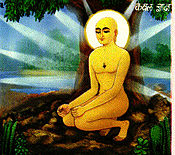
Mula Bandha
Encyclopedia

Iyengar (1976: p.525) defines Mūla Bandha as:
This is qualified in that the actual muscle contracted is not the sphincter
A posture where the body from the anus to the navel is contracted and lifted up and towards the spine.
Sphincter
A sphincter is an anatomical structure, or a circular muscle, that normally maintains constriction of a natural body passage or orifice and which relaxes as required by normal physiological functioning...
muscle nor the muscle which cessates urination, but the muscle equidistant between the two.
Maehle (2007: p.11) defines it as "root lock" and further specifies that:
The root referred to here is the root of the spine, the pelvic floor or, more precisely, the centre of the pelvic floor, the perineum. The perineum is the muscular body between the anus and the genitals. By slightly contracting the pubo-coccygeal (PC) muscle, which goes from the pubic bone to the tail bone (coccyx), we create an energetic seal that locks prana into the body and so prevents it from leaking out at the base of the spine. Mula Bandha is said to move prana into the central channel, called sushumna, which is the subtle equivalent of the spine.
Mūla Bandha is the principal, key and primary Bandha of the Yogic Traditions
Yoga
Yoga is a physical, mental, and spiritual discipline, originating in ancient India. The goal of yoga, or of the person practicing yoga, is the attainment of a state of perfect spiritual insight and tranquility while meditating on Supersoul...
. Mūla Bandha is endemic to all safe, grounded workings of bodymind disciplines. This Bandha in and of itself conditions the Muladhara
Muladhara
Muladhara is one of the seven primary chakras according to Hindu tantrism. It may be represented by the color red, although its root square form is usually yellow.-Location:...
Chakra
Chakra
Chakra is a concept originating in Hindu texts, featured in tantric and yogic traditions of Hinduism and Buddhism. Its name derives from the Sanskrit word for "wheel" or "turning" .Chakra is a concept referring to wheel-like vortices...
, simultaneously keening, rooting and engaging the systemic plethora of processes that constitute bodymind and with diligence resolving them in discipline and accord. Mūla Bandha should be held as a restraint only after kumbhaka
Kumbhaka
Yoga and pranayama are the most accepted holistic exercises for absolute health as explained by biopsychosocial model. Pranayama is the breathing exercise highly recommended for various physiological and psychological disorders...
, which in this instance is where the breath is expressed in its entirety and held outside the body. Iyengar (1976: p.435) likens the functionality of the Bandha
Bandha
Bandha is a Sanskrit term for "binding, bond, arrest, capturing, putting together" etc.It may refer to:*a technical term in Hatha Yoga, see Bandha *one of the tattvas in Jainism, see Bandha -See also:...
and especially Mūla Bandha to "safety-valves which should be kept shut during the practice of kumbhakas".
Iyengar (1976: p.437) specifies the energetic prāṇas of Vāyu
Vayu
Vāyu is a primary Hindu deity, the Lord of the winds, the father of Bhima and the spiritual father of Lord Hanuman...
engaged through Mūla Bandha as: "...Apāna Vāyu (the prāṇa in the lower abdomen), whose course is downwards, is made to flow up to unite with Prāna Vāyu, which has its seat within the region of the chest."
Iyengar (1976: p.437) cautions that:
Mūla Bandha should be attempted first in antara kumbhaka (retention after inhalation). The region of the lower abdomen between the navel and the anus is contracted towards the spine and pulled up to the diaphragm.
Iyengar (1976: p.437) states that: "While practicing Mūla Bandha, the yogi attempts to reach the true source or mūla of creation."

